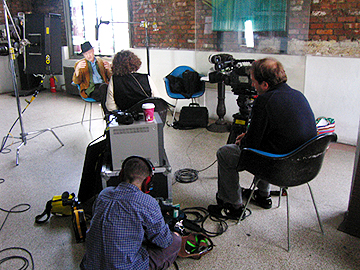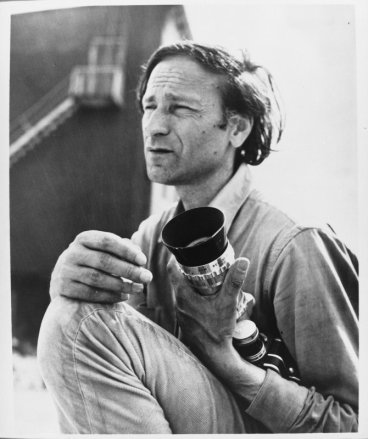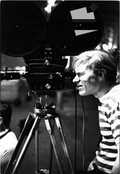The Jonas Mekas Interview

How did you first meet Andy?
It was in 1962 that we created Filmmakers Co-operative and we also established a little showcase, Filmmakers Showcase, where we began screening films every weekend. So my home became an office and meeting ground for underground filmmakers, that’s what they used to be called. And every day, every evening, they used to bring their films and show them to each other, and that’s where I met Warhol. I did not even know who he was, you know. I did not recognize him at first. He had to be introduced. But he was there on the floor. We had no chairs to watch movies.

Young filmmaker Jonas.
So, we began screening films at the Filmmakers Showcase in ’62, ’63, and that’s where a lot of early Warhol films were shown. At first, he made a series of “Kisses”, usually projected before our main program, whatever it was. And that is also where “Sleep” was premiered.
I think, that was already in 1963. Andy was there at the screening, and as a joke, because everybody said, “Who could sit through six hours , a long film, you know. Now, you know, it’s very normal, not in ’63. So, as a joke, I got a rope, and I tied Andy to the chair (laugh) as people said, “You should see it yourself, you better not leave it.”And of course I have not only to watch the films, I have to oversee the projection. So at one point I went to the projection room, and (when) I came out, it was like an hour later, and Andy was gone. (laughter) He was gone, but he had already seen the film, it had been projected at the Factory.
Tell me about “Empire”….?
A young man by the name of John Palmer was helping me on ‘Film Culture Magazine’ that I was editing, and he was also helping me to do physical work, like take packs of the magazine to the post office, and the post office was in the Empire State Building. So at one point, as we were approaching the Empire State Building, we stopped to admire it, and John Palmer says, “Ah! This would be a perfect film for Andy Warhol.”.
So I said, “Why don’t you tell this to Andy?”. So John Palmer told this to Andy, and Andy said, “Yes! Let’s do it, let’s film it.”. And so a few days later, Andy decided, or maybe both of them decided, that it should, we should, start filming early before sunset, then go all night until sunrise, more or less. I was asked to be the cameraman because I knew, uh, that Andy was operating only with a little Bolex that took only two minutes and forty five seconds of film. I decided to use only one camera that takes thirty minutes of film. And nobody else knew how to operate. So I had to act as a cameraman on that film. So, I framed it, and I said “Andy, take a look, what do you think?”. He said, “It’s okay, go ahead.”. So we spent the night eating sandwiches in the Time Life Building. I don’t remember the floor, maybe thirtieth floor or something like that, and uh, I kept shooting, I kept changing the magazine, and that was the film.
A month or so later, we opened it. The first screening took place at the, what was known as City Hall Cinema, it’s very close. Now there is Pace University there. It was a regular movie house that was torn down two or three years later, after the screening of “Empire”. They had about three hundred people, and they came with sandwiches, some came with sleeping bags, and (laughter) people kept coming in and out, and at the end we had some forty or fifty people, still.
Do you think Warhol was influenced by going to your place and seeing all these early underground movies?
Absolutely. He had two film schools, 42nd Street, the commercial public cinema, and then my home where he saw all, you know, he met there all, like most of his Superstars, future Superstars there. That’s where he met Paul Morrissey and Taylor Mead and then they went west and they made, uh, “Tarzan and Jane Regained”, the first film they made. It was not exactly a Warhol film, it was a group, more or less, a group project.
The real Warhol began with “Kisses” and “Sleep”. And then of course, that was also a period when art and time became very important. I mean LaMonte Young playing a single musical note for five, six, seven hours. And I went with Andy to LaMonte’s concert, on, I think, Second avenue. So Andy was very familiar, I mean, Andy was not an amateur or naïve artist, He was very much in touch with everything that was happening in all of the arts. And he adopted and used and transformed (things), you know, in his own way. So that was very much in the air, already. That is why a six hour film. By the way, the man sleeping (in “Sleep”) was the poet John Giorno, and I heard, not long ago, that he still had the mattress in the attic, he still has the mattress in the attic.(Laugh) It will be auctioned probably, at Sotheby’s. (laughter)
What did you think about how Andy treated his coterie of Superstars?
The first ones came from the underground, from the friends of filmmakers that he met, those who had been in the films of Jack Smith or Ron Rice.
But then of course, the second set was other people, the lonely desperate souls that came from Paris, from St. Paul, from different places, parts of the country, and they somehow ended up at the Silver Factory. And Andy was one who never said no, never rejected. Everyone felt very much at home, nobody disapproved. So sad and desperate as they were, they felt like home. Andy was like their big father. He never scolded them, never disapproved, they were very free. They were permitted when the sound period began, they were permitted to improvise, to say whatever they wanted to, unload themselves. So (it) became like a psychoanalyst’s office. Later, of course, newspapers said, “Oh, he destroyed, you know, some of them committed suicide, and some, you know, this and that.”.
No, no ! Some of them had maybe the only happy moments they had in the Factory. They came from some very confused backgrounds.. I think they were helped, really, they were not destroyed at the Factory. Those who self-destructed, they were already, they were too far gone, nobody could help them anymore. But Andy was a very, very, kind person. And everybody felt very, very good in his presence. And I disagree with all those accusations that are sometimes thrown at Andy. There were other misunderstandings like, “Oh, he went up to, he just went up to the rich people.” No, they came to him, he did not go after them. They all came. I know. I’d been around. They just flocked to him. They did that because of that openness, because it was like, you know, he did not reject anybody.
And the society people paid. They needed, you know, exposure, they needed a picture in newspapers. Andy certainly didn’t need it. But they needed it. So they flocked to him. They searched him out. He did not go after them. He was always on the side, like later on, Studio 54, discothèque. I have been many times there, and Andy was always on the side, somewhere with his tape recorder or his Polaroid. I never saw him dance. He was never really in the middle, he was always like an open eye, like gazing.
What else influenced Andy’s filmmaking technique?
When Andy went into the sound, he needed more assistance, more people who knew more about film and cameras and sound. And those assistants began imposing their own styles, views, contents. I mean much of the time Andy asked them to do this and that and that, like with the early two films with Mario Montez, when actually he himself, there’s a lot of zooming in zooming out and he did that himself. And he asked others, you know he was fooling around with that technology, so to speak. And then young budding playwrights came in with suggestions like Ronnie Tavel with some scripts. So other people began coming in. Then Paul Morrissey became very, very powerful. So it was a combination already, not just pure Andy.
What were the different stages of Andy’s filmmaking?
In Andy’s cinema there were several stages. First, the silent. The camera gazes, looks for a long time. “Sleep”, “Haircut”, “Mushroom”, “Eat”.
That (second) period where he went into sound, the reason for, I will tell you why. It happened that I filmed “The Brig”, a theatre piece for the Living Theatre. We went one night onstage with actors, and I did it in one night, sort of secretly, and I needed a sound camera. So I chose (an) Auricon camera which records image and sound. So I did it with sound on film and the next day I developed it. And the evening of the next day after I shot, I screened, I checked it, and I invited Andy and the Living Theatre people. And so Andy just happened to pass by. And he sat through it, and he was so impressed with what you can do with this camera, you can do sound and image, and so easy right there, you know, one person. By myself. I was a one man team. And that is what got him. So he got an Auricon. And he shot with the camera for the early sound films, and that is (laughter) when he went into this early sound period.
That’s when he was permitting people that were around the Factory, and some people that he invited, the early stars, to improvise, those who were hanging around, after he ran out of ideas, so they were minimal, just imitations of a script, you know, of some certain themes, etcetera.
The scripts came in, and then of course, they became more and more complex until ah, “Chelsea Girls”. Some producers approached Andy and thought that maybe he’s ready for something that could play for wider audiences across the country. But there was a lot of press and of course, he produced, he made three or four films. But they didn’t work, because they were no longer Andy’s films. They were, they did not have too much action, ah, much action or anything else attractive enough to be booked across the country, even if it’s on a small scale. So that was phased out.
And that was really the end of Andy’s cinema, in a way, because already at that point Paul Morrissey was very involved in the sound period, later sound period with the sound he had, he wanted to make his sound, have complete control. He used a lot of the same people. The same stars, (and) of course the other reason for the end was Valerie Solanas who shot Andy.
What was the importance of Warhol’s films?
You can look through those films and the whole period comes in a very concentrated way. The same, like, okay, you go to Eisentstein, to Renoir, to Rossellini, and nobody can make films like Renoir, nobody can make films like Eisentstein, and nobody can make films like Andy. It cannot be repeated.
So there was something that was him, and nobody else can do that. He used everybody around him to produce that whole body of work, and that cannot be repeated. So that, those people wrote, “Oh, all the people now, everybody will make films like that.” No. Nobody makes. Andy is gone. When Andy was still even alive, that period was finished. His cinema, unique, he came into a very unique world, that is recorded and those films’s unique sensibility and content. It’s a treasure for the future. People who want to find out something of the period, about a certain part of the society, they will have to see his films.
He surrounded himself with a certain kind of people that came to him. There were some people that did not come to him at all. They would not tolerate this being, maybe too open, or the atmosphere, or, so that there was like a natural selectivity. It was not just hodge-podge, anything goes. No, no, I think there was a natural selection. Selectivity of some kind, like in all of nature. And the same of course applies to his other activities. I mean, it’s endless.
What about the “Screen Tests”?
We still have not seen, people have seen maybe only twenty or so portraits that he did. There used to be a chair, and a Bolex, a motorized Bolex, and anybody new who came into the Factory was asked to sit there and perhaps for two minutes, forty five seconds of film, whatever was run. And you sit there, and it’s very, when you see those, they were called ‘Screen Tests’, about four hundred or so of them. And very interesting what happens, what some people would, you know, sit there, you don’t know what to do, and then, some begin to like argue and fight, or dance with the camera, or make faces or whatever. Very interesting what different people do, when they are just by themselves and the camera there. There is no cameraman, the camera is running there, and there is you. And now what do you do? You know, you pace yourself, when you face the camera. Those four hundred or so screen tests, portraits, unique collection of portraits of people of that period, and they have not been shown yet. None of them.
He taped audiotapes with this little tiny Sawyer or whatever you call it, the recorder is always there in his hand or in his pocket, everywhere, wherever he was, thousands and thousands. And when you listen to them again, the whole period is there, and all the special people.
A gallery in London is preparing to have a show of some of those tapes. Another Warhol that is not yet seen, and people have yet to know.
And there was a period, when those audiotapes were simply dismissed, like, oh, you know, you tape someone, horrible mistake, horrible mistake. And they’re not taking those screen tests yet seriously, also. They’re not shown. It’s a monumental collection of portraits from, I mean, unknown people and known like Duchamp, etcetera, they’re all there, in those portraits. I don’t understand at all the attitude of some museums and galleries.It’s a monumental work. Art pieces. You don’t have to call them art, they’re just monumental creations.
Did you know Edie? The Velvets?
Edie Sedgwick was a very, very sweet person. I introduced the very first public appearance of The Velvet Underground with Edie. We introduced them to the Psychiatrist’s convention. That’s where (laugh) the first public performance of the Velvet Underground took place, at a Psychiatrist’s convention. (laugh) First we screened “Eat”, and I sort of tried to explain, my little speech, and Edie spoke a little bit, and then the Velvet Underground went on. I just have one minute or so of footage.
Well she did drugs, and constant delinquency. When the parents wanted to get her out, they, the police said that if somebody would sort of give her a little job, and supervise her and see that she goes straight, or they would let her go. So they asked me, her parents, if I would do that. I said okay, sure, let her come. So she came and she was working for me, helping for a year or two. She was very very open, very, very bright. She knew practically most of Neitzche’s “Thus spoke Zarathustra” by heart. So, she befriended all the filmmakers and all the poets, and before you knew it, everybody, so it was she who brought the Velvet Underground to me. You know at the Cinematheque. They began to practice there, play to films, and before, taking them to Andy.
Before Barbara Rubin took Lou Reed to Andy and Andy said, “Oh, let’s do something.”. And of course, it was Barbara Rubin who changed Bob Dylan after the motorcycle crash into a, converted him, for good or bad, into Judaism. And etecerta. And then Barbara went to London and befriended the Beatles, and there’s a long story there.
